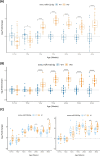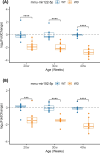Profile of plasma microRNAs as a potential biomarker of Wilson's disease
- PMID: 39060521
- PMCID: PMC11415402
- DOI: 10.1007/s00535-024-02135-6
Profile of plasma microRNAs as a potential biomarker of Wilson's disease
Abstract
Background: Wilson's disease (WD) is a rare condition resulting from autosomal recessive mutations in ATP7B, a copper transporter, manifesting with hepatic, neurological, and psychiatric symptoms. Timely diagnosis and appropriate treatment yield a positive prognosis, while delayed identification and/or insufficient therapy lead to a poor outcome. Our aim was to establish a prognostic method for WD by characterising biomarkers based on circulating microRNAs.
Methods: We conducted investigations across three cohorts: discovery, validation (comprising unrelated patients), and follow-up (revisiting the discovery cohort 3 years later). All groups were compared to age- and gender-matched controls. Plasma microRNAs were analysed via RNA sequencing in the discovery cohort and subsequently validated using quantitative PCR in all three cohorts. To assess disease progression, we examined the microRNA profile in Atp7b-/- mice, analysing serum samples from 6 to 44 weeks of age and liver samples at three time points: 20, 30, and 40 weeks of age.
Results: In patients, elevated levels of the signature microRNAs (miR-122-5p, miR-192-5p, and miR-885-5p) correlated with serum activities of aspartate transaminase, alanine aminotransferase and gamma-glutamyl transferase. In Atp7b-/- mice, levels of miR-122-5p and miR-192-5p (miR-885-5p lacking a murine orthologue) increased from 12 weeks of age in serum, while exhibiting fluctuations in the liver, possibly attributable to hepatocyte regenerative capacity post-injury and the release of hepatic microRNAs into the bloodstream.
Conclusions: The upregulation of the signature miR-122-5p, miR-192-5p, and miR-885-5p in patients and their correlation with liver disease progression in WD mice support their potential as biomarkers of WD.
Keywords: Drug monitoring; Prognosis; miR-122-5p; miR-192-5p; miR-885-5p.
© 2024. The Author(s).
Conflict of interest statement
G. González-Aseguinolaza is Vivet therapeutics employee and shareholder. No sponsor had a role in the study design, the data collection, the analysis and interpretation of data, the writing of the paper or the decision to submit the article for publication.
Figures




References
-
- Liver EAftSot. EASL Clinical practice guidelines: Wilson’s disease. J Hepatol. 2012;56:671–685. - PubMed
Publication types
MeSH terms
Substances
Grants and funding
LinkOut - more resources
Full Text Sources
Medical

